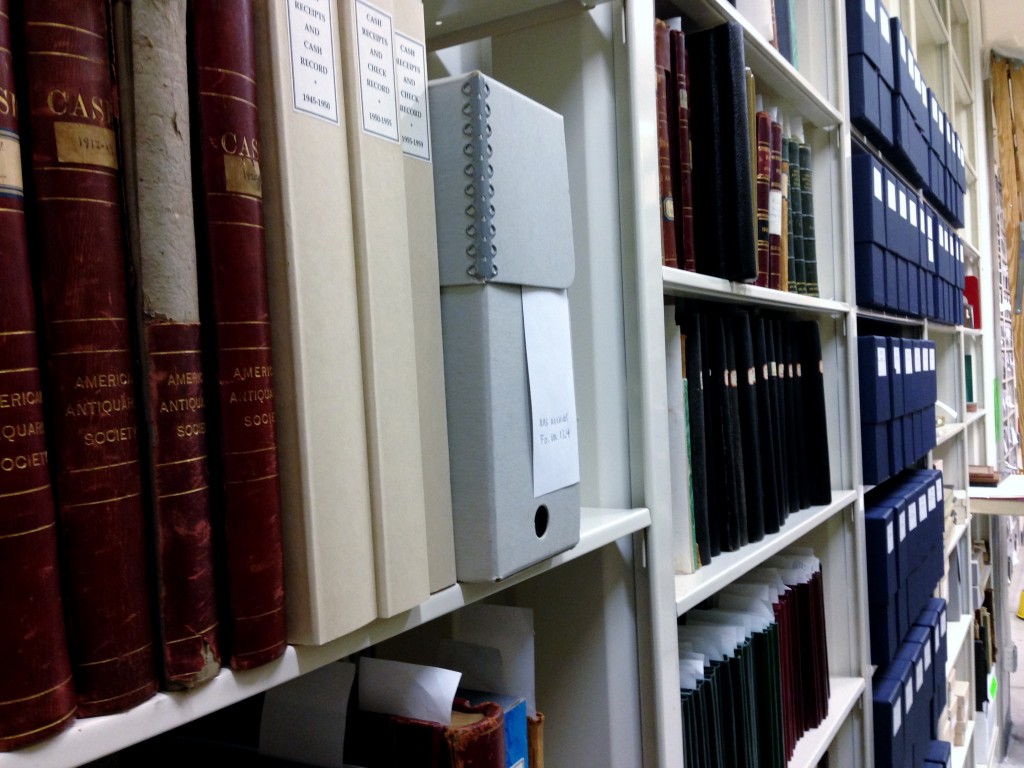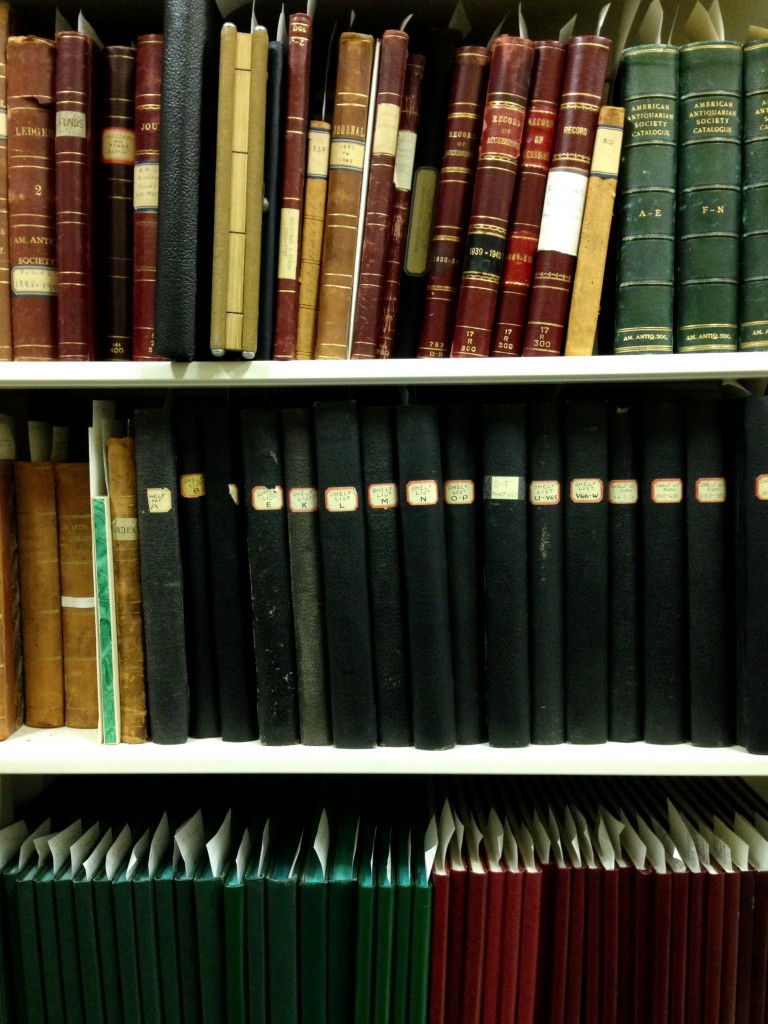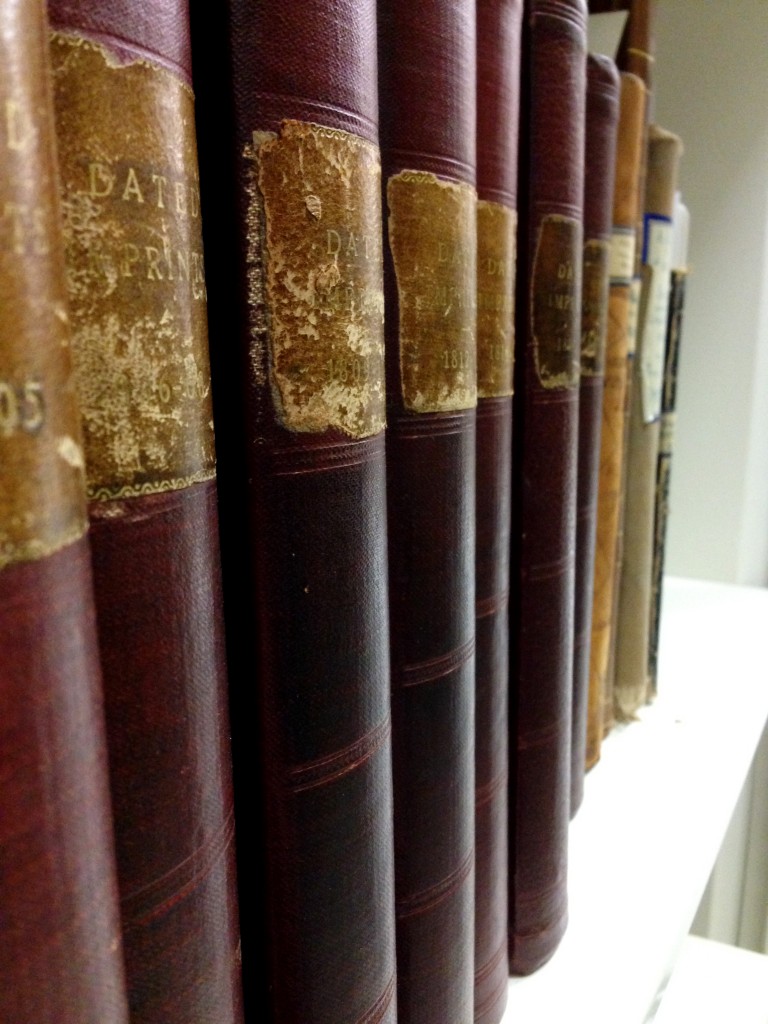“All this, all of this love we’re talking about, it would just be a memory. Maybe not even a memory. Am I wrong? Am I way off base? Because I want you to set me straight if you think I’m wrong. I want to know.”
Raymond Carver, What We Talk About When We Talk About Love
 “Archive” has become an incredibly capacious word. Or perhaps it is more accurate to say that the word’s meaning and level of precision it describes greatly depend on the context in which it is deployed. Practitioners trained in library information science (LIS) usually reserve the word to refer to institutional records. In this context, AAS President Ellen S. Dunlap has been known to remark that AAS in fact only holds one archive: that of the AAS institutional records. This might confound some who refer to the total holdings of AAS (or any other special collections library) as an archive, thinking that anything in special collections (and I am using “special collections” to mean non-circulating print and manuscript materials) is an archive, or perhaps that anything that is not in a codex is an archive. One reason that I find the definition that Dunlap and other LIS practitioners have in mind useful is that it helps to distinguish between collections that are vetted for content worth keeping and those that are preserved in full. An archivist’s job, in this context, is not only to inventory materials to create finding aids and catalog records, but it is also to winnow: to sort through the copious correspondence, records, etc. of an institution and decide what is wheat and what is chaff. Archival “appraisal” in this context does not mean determining how much an object or a group of objects are worth in the monetary sense, but rather whether they should be preserved. It is worth knowing, therefore, when one approaches such a collection if it is in fact an archive in this sense, if it has been winnowed or if it is being preserved in tact, just as it was acquired.
“Archive” has become an incredibly capacious word. Or perhaps it is more accurate to say that the word’s meaning and level of precision it describes greatly depend on the context in which it is deployed. Practitioners trained in library information science (LIS) usually reserve the word to refer to institutional records. In this context, AAS President Ellen S. Dunlap has been known to remark that AAS in fact only holds one archive: that of the AAS institutional records. This might confound some who refer to the total holdings of AAS (or any other special collections library) as an archive, thinking that anything in special collections (and I am using “special collections” to mean non-circulating print and manuscript materials) is an archive, or perhaps that anything that is not in a codex is an archive. One reason that I find the definition that Dunlap and other LIS practitioners have in mind useful is that it helps to distinguish between collections that are vetted for content worth keeping and those that are preserved in full. An archivist’s job, in this context, is not only to inventory materials to create finding aids and catalog records, but it is also to winnow: to sort through the copious correspondence, records, etc. of an institution and decide what is wheat and what is chaff. Archival “appraisal” in this context does not mean determining how much an object or a group of objects are worth in the monetary sense, but rather whether they should be preserved. It is worth knowing, therefore, when one approaches such a collection if it is in fact an archive in this sense, if it has been winnowed or if it is being preserved in tact, just as it was acquired.
 In Archive Fever (1994), Jacques Derrida very much has this institutional dimension of archives on his mind. “A science of the archive,” he says, ”must include the theory of this institutionalization, that is to say, the theory both of the law which begins by inscribing itself there and of the right which authorizes it.” It is Derrida’s explication of the word and the “notion” of the archive through Freudian psychoanalysis that has secured this lecture’s place as a watershed moment in the theorization of archives. The word then became a signifier in new ways. For humanities scholars, archive might now refer to the historical record, to any and all things preserved, to non-things that undergo a sort of process of preservation (I’m thinking here of what Ann Cvetkovich calls for in her seminal work An Archive of Feelings: Trauma, Sexuality, and Lesbian Public Cultures (2003), in which she takes her cues very much from Freud and Derrida), to objects in closed stacks, and to institutions that contain such objects.
In Archive Fever (1994), Jacques Derrida very much has this institutional dimension of archives on his mind. “A science of the archive,” he says, ”must include the theory of this institutionalization, that is to say, the theory both of the law which begins by inscribing itself there and of the right which authorizes it.” It is Derrida’s explication of the word and the “notion” of the archive through Freudian psychoanalysis that has secured this lecture’s place as a watershed moment in the theorization of archives. The word then became a signifier in new ways. For humanities scholars, archive might now refer to the historical record, to any and all things preserved, to non-things that undergo a sort of process of preservation (I’m thinking here of what Ann Cvetkovich calls for in her seminal work An Archive of Feelings: Trauma, Sexuality, and Lesbian Public Cultures (2003), in which she takes her cues very much from Freud and Derrida), to objects in closed stacks, and to institutions that contain such objects.
I write less to nail down a definition and to delimit the meaning of the word than to begin to map the word’s capaciousness. Even when we mean archive in a specific sense, a meaning of which we are certain, we have no assurance that our interlocutors will take the term to signify the same exact thing. The scale of the term and the processes that might define it as such have been lost, and some might argue that without such precision the word is now useless. In other words, if what is signified by the word comes to include too much, then might the word lose its usefulness? If any object or collection of objects can be an archive, then is anything really still an archive in a meaningful way?
 I end where I began then: with Raymond Carver on love. I wonder if we might say the same about archives, that we know that archives have to do with memory and that which we can know about those memories (what Derrida calls “impressions”), but that it constantly behooves us to define what we mean when we use these terms. To further riff on Carver’s title then, we might need to point out that which the “what” of our talking signifies when we talk about archives. This act of definition is more imperative than ever as scholars trained in the humanities and those trained in library science are increasingly working together on digital humanities projects and initiatives. Such collaboration facilitates the collapse of disciplinary boundaries in new and exciting ways, but we all risk talking past each other if we do not take time to define our terms and to know how others might think about them differently.
I end where I began then: with Raymond Carver on love. I wonder if we might say the same about archives, that we know that archives have to do with memory and that which we can know about those memories (what Derrida calls “impressions”), but that it constantly behooves us to define what we mean when we use these terms. To further riff on Carver’s title then, we might need to point out that which the “what” of our talking signifies when we talk about archives. This act of definition is more imperative than ever as scholars trained in the humanities and those trained in library science are increasingly working together on digital humanities projects and initiatives. Such collaboration facilitates the collapse of disciplinary boundaries in new and exciting ways, but we all risk talking past each other if we do not take time to define our terms and to know how others might think about them differently.
